Issue #08: Our 5 Day Road Trip Through the American Southwest
A dog friendly guide to Arches, Bryce Canyon, Zion, Monument Highway and the Grand Canyon, plus everything I'd do differently if we did it again
📖 What working with clients has taught me about burnout: For anyone who’s experienced burnout (let’s be honest, who hasn’t?), this recent post by Leslie Stevens is a great read. With insights into how burnout can mimic depression, she offers a raw and relatable take on managing emotional fatigue, while giving practical strategies to prevent and cope.
📖 Nightbitch: I’m currently working my way through this quirky and outrageous novel, about a mother who, after putting her ambitious art career on hold to stay at home with her newborn son, begins to suspect that she might be turning into a dog. As she experiences strange new physical changes and animalistic urges, she grapples with her identity, desires, and expectations of motherhood as a whole.
Sitting on the porch of a quaint farm house tucked away in the rolling green hills of Northern California, it’s hard to imagine that a few short weeks ago we were caravanning our way through the American Southwest, checking National Parks off of my bucket list in a swirling beef jerky fueled haze. By the end? I was exhausted. Would I do it again? In a heartbeat.
Doing this road trip with a dog certainly posed it’s own unique set of challenges, but is totally do-able with a few mindful adjustments.
Read on for:
Our 5 day route, the parks and all of the scenic stops we found along the way
Some interesting history and fun geological facts about the area
Tips for visiting the American Southwest & National Parks with a dog
Everything I’d do differently if we did it again!
Time: 7 Hours
Notable Stops: Colorado National Monument
Where we Stayed in Moab: Dog Friendly Airbnb in Moab
Aiming to avoid the Colorado ski traffic, our little crew hit the road at around 5:30AM, chasing the sun around the winding mountain roads of Western Colorado. After an hour or two of driving, we made a quick pit-stop at a funky little coffee shop in Nederland to pick up breakfast and feed Violet before settling in for a 5-hour stretch through the mountains to arrive at the Colorado National Monument.
Snow-capped mountains made way to bone-colored badlands1 and regal red rock vistas, carrying us toward the towering monoliths of the Colorado National Monument2. This stop only added a small amount of time to our journey to Moab and is one that I’d absolutely recommend to anyone else making the trip. While the monument did have a variety of hikes to explore, they weren’t dog friendly, so instead we let Violet stretch her legs at the Visitor’s Center Picnic area before enjoying the views as we cruised down the winding canyon roads of Red Rock Rim Drive.
The Colorado National Monument is only 2 hours from Moab, and since we would only be spending one night there, we decided to maximize our time and head straight into Arches National Park with Violet before checking into our Airbnb. Bringing her along meant we wouldn’t be able to enjoy any of the hikes in the park, but luckily, many of the views the park is known for can be accessed from various lookout points accessible via scenic drive.
Arches Scenic Drive:
Distance: 36 miles round trip that took us 2-3 hours to complete
What You Need: Like all National Parks, you will need an America the Beautiful National Parks Pass to enter the park, or pay the parks daily entry fee. Depending on the time of day, you can expect a short wait before gaining entrance.
History: While Arches is a natural wonder all on it’s own, it really comes to life when you learn the history of the park, and how these otherworldly rock formations came to be 65 million years ago. If you’re not bringing your dog, I’d highly recommend a stop into the Visitors Center, or read up on the geological and Indigenous connections to the land before visiting for the full experience.
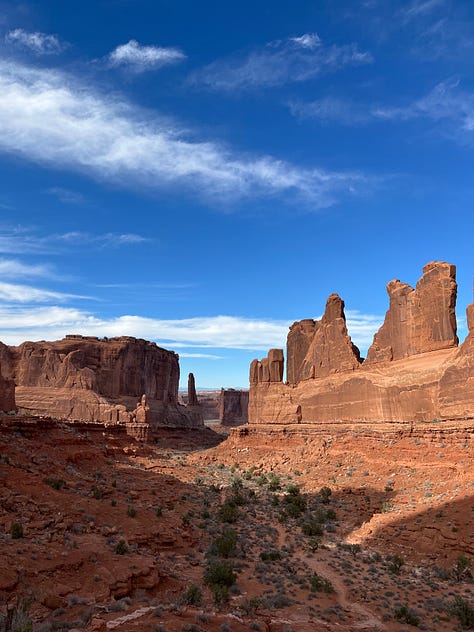
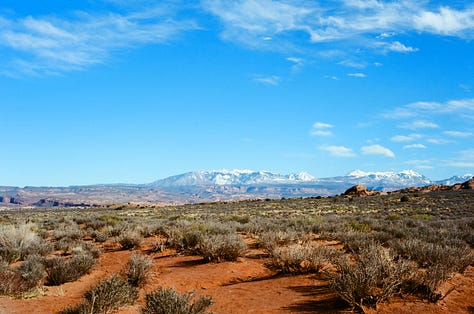
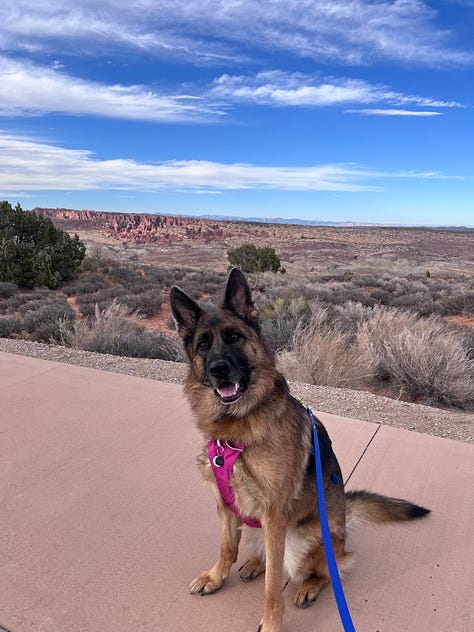
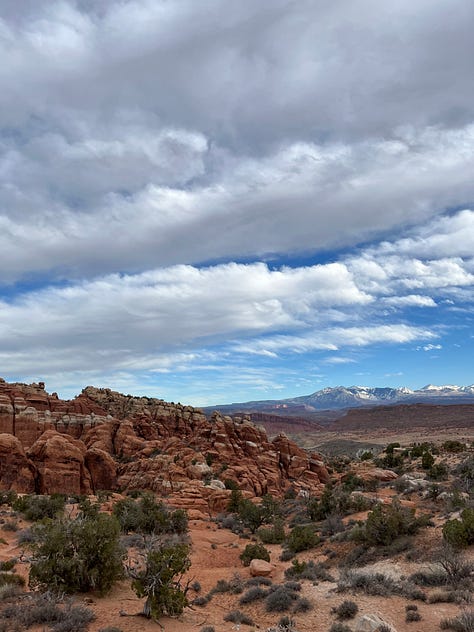
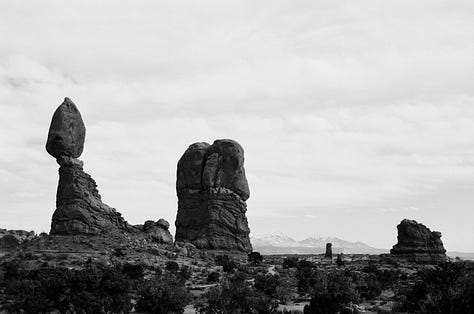
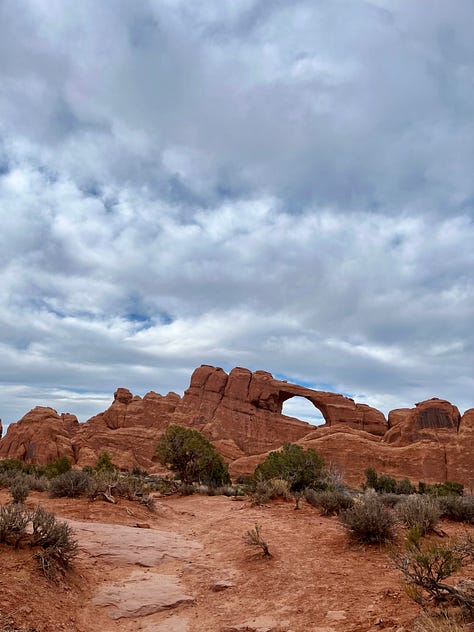
If you aren’t planning on hiking, Arches is actually much more dog-friendly than I had expected. Almost every scenic lookout has a dedicated parking lot where dogs can get out and walk (on a 6ft leash, staying on the paved areas), and allowed us to see the iconic views of Balanced Rock, Fiery Furnace, Delicate Arch Viewpoint (although this would be much better experienced through the short hike out to the arch its self), and more.
After stopping at almost every lookout, the entire drive took us about 3 hours round trip. Although I would have loved more time to explore this park on foot, we left feeling satisfied and ready to turn in for the night.
Time: 6-9 Hours
Notable Stops: Valley of the Gods, Mexican Hat & Monument Valley (+ 3 hours)
Where we Stayed in the Grand Canyon: Holiday Inn Resort: The Squire at Grand Canyon
After the prior days early wake up, we decided to sleep in a bit before another long day on the road. We woke leisurely, re-loaded the car and stopped at a local coffee shop for breakfast sandwiches (Pro Tip: swap ham for bacon & add avocado - you’ll thank me later ;) & coffee.
The biggest suggestion I have for anyone taking a similar trip is that one night in Moab is not enough time—especially if you’re traveling with a dog. By the time you work around check-in/check-out times, you’ll need at least two nights in the area to enjoy some dog free time without feeling rushed.
But alas, we only penciled in one day, and because we wanted to spend sunset at the Grand Canyon, we decided to check-out Monument Valley, Mexican Hat, and Valley of the Gods (all dog friendly) in lieu of an early morning hike through Canyonlands. I’ll admit, having not heard of Monument Valley previously, I was initially a little disappointed when we adjusted our itinerary to skip Canyonlands. So you can imagine my surprise when it actually ended up being one of my favorite parts of the entire trip. Not only was the drive to get to these iconic views of the southwest incredible (cue: me asking to pull over every 15 minutes so that I could get out and take photos), but the actual sights themselves were way more impressive than any picture could do justice.
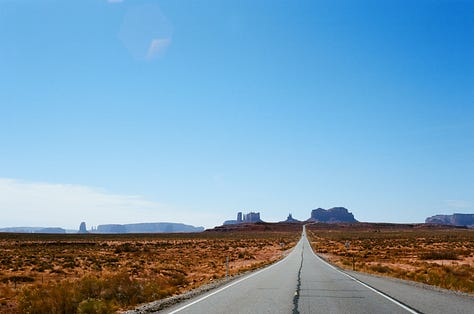
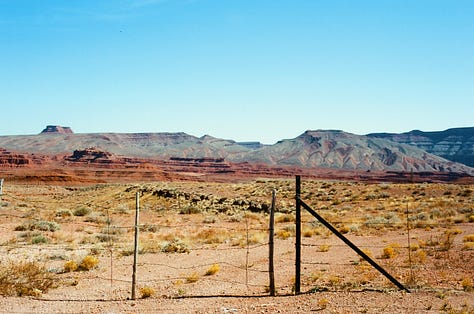
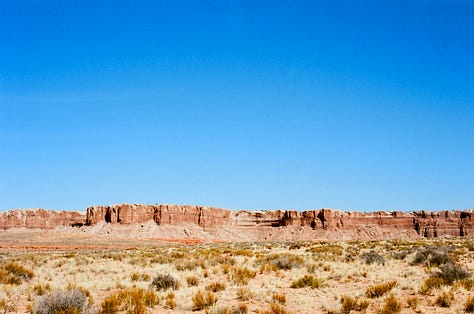
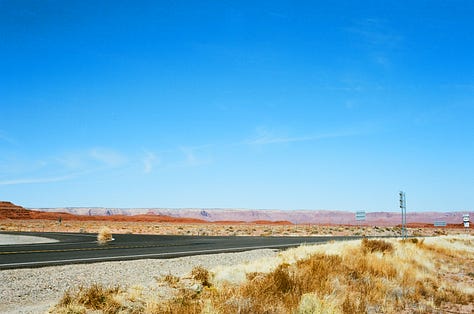
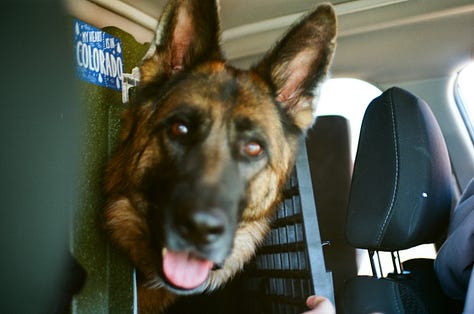
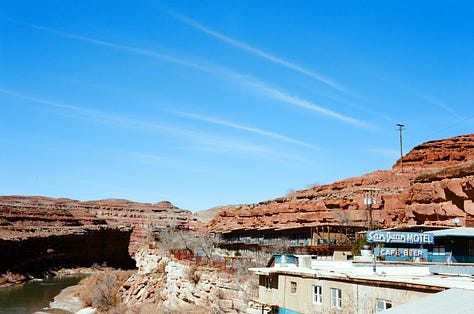
Valley of the Gods & Mexican Hat
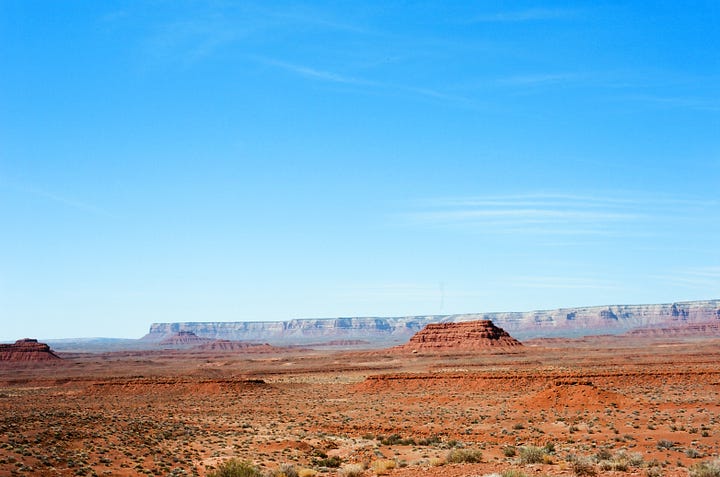
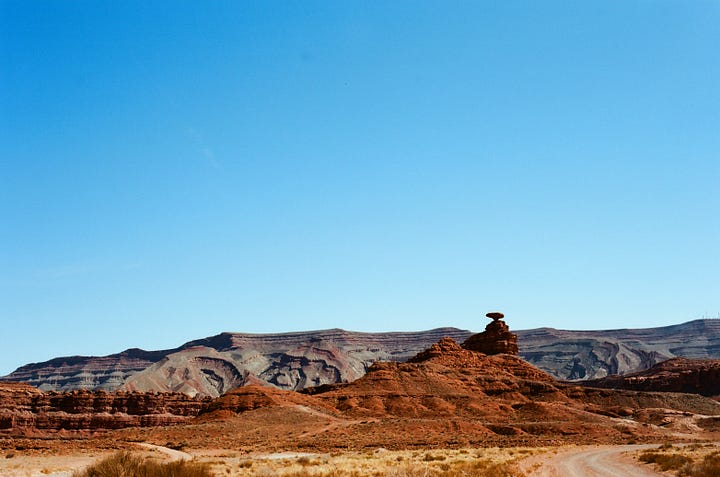
Distance: Valley of the Gods (17 Mile Loop) & 13 Miles to Mexican Hat. While we didn’t drive the entire loop, we did spend about an hour soaking in the views before continuing south to Monument Valley.
What you’ll need: This scarcely marked gravel road off of Route 163 is free to the public. Just make sure that your car has 4WD to make it through unpaved dirt roads.
History: The towering buttes and red sandstone pinnacles date back over 250 million years and is sacred to the Navajo, whose land is home to a majority of the wonders explored on this route. The striking Bears Ears area around the valley is home to over one hundred thousand sites of cultural significance. Legend has it, that the giant red rock spires are the remnants of their warrior ancestors, frozen in time. Unlike Monument Valley, Valley of the Gods is managed by the Bureau of Land Management and sees much less traffic than its southern neighbor, making it a great spot to get a taste for the striking landscape of the American Southwest.
Monument Valley Scenic Drive:
Distance: 17 mile loop, taking about 2 hours to complete
What you’ll need: Monument Valley is managed by Navajo Nation, and your National Parks Pass won’t be accepted here. Entrance is $8 per person to access the park, and is absolutely worth it. It’s also worth noting, that like Valley of the Gods, these dirt roads are rough, so please check the weather conditions before visiting.
History: Thanks to millions of years of erosion and sandstone deposits, what was once an unassuming lowland basin, is now home to sandstone buttes of up to 1,000 feet. The Navajo people settled in the area in the 15th and 6th centuries, protecting the valley and ultimately establishing the Monument Valley Tribal Park in 1958 that we visit today.
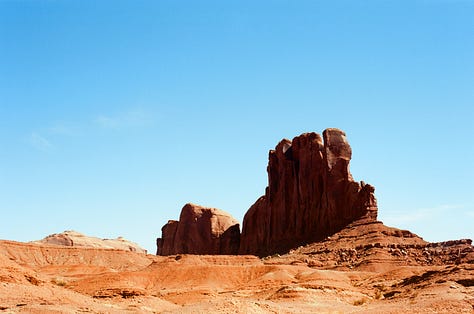
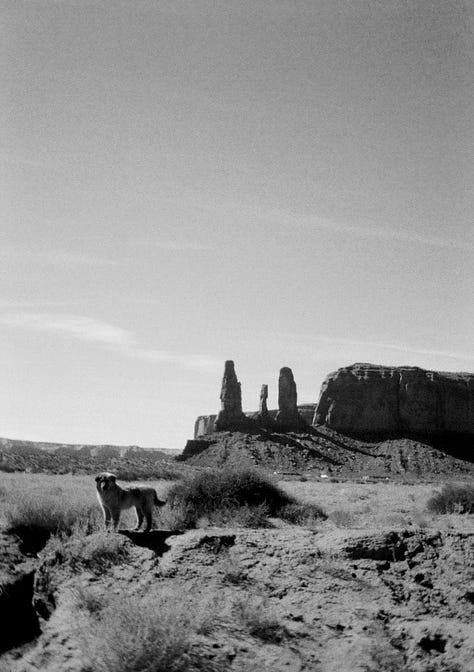
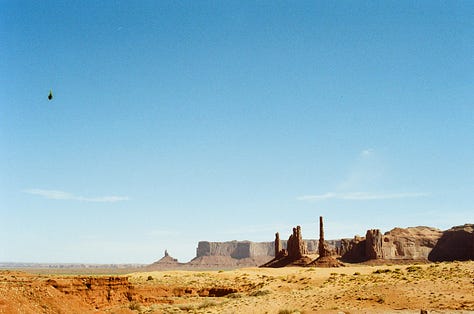
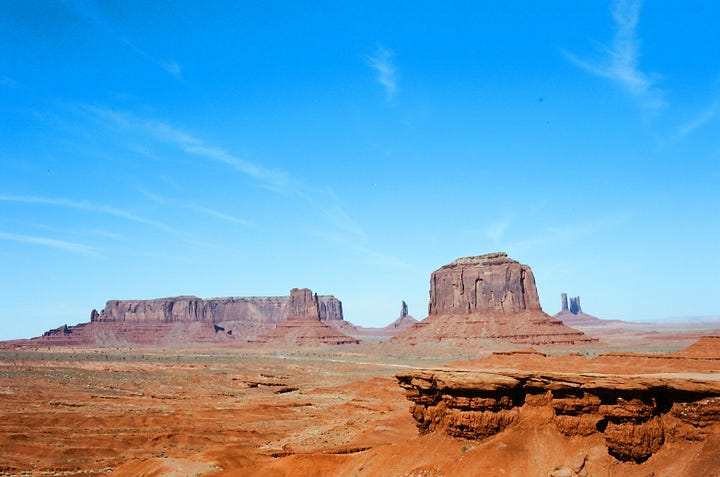
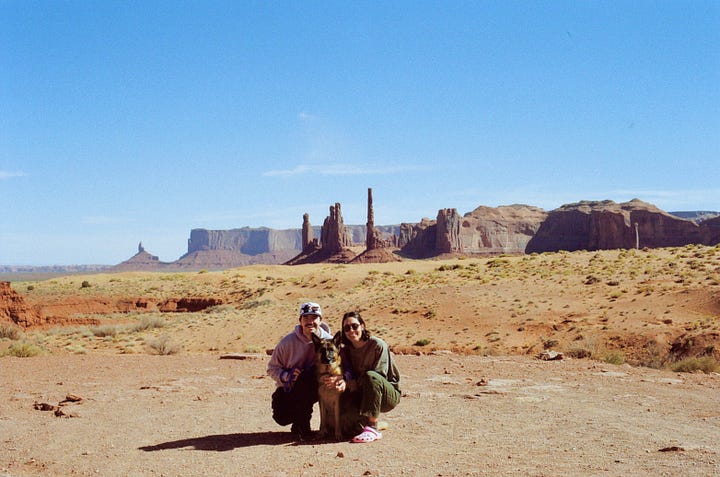
Because this was my first time visiting the Grand Canyon, my boyfriend was set on getting there at sunset so that my “first look” would knock the air out of my lungs. In total we probably spent ~3 extra hours sightseeing in Monument Valley and the surrounding areas, but I absolutely could have spent longer had we not been on a time crunch.
Chasing the late afternoon sun, rocky canyon roads made way for the twisted juniper of Kaibab National Forest as we approached the park’s South Rim entrance. The sky was a canvas of bright blue, dotted with the kind of soft, pillowy white clouds that almost always guarantees a good sunset.
Pulling up to the northern entrance of the South Rim, a tenured Parks worker greeted us with a smile. “Do you think she’ll like it?” he asked with a wink when he learned it was my first time before sending us on our way.
It’s not that I was ever a Grand Canyon nay-sayer, but I’d be lying if I said I wasn’t expecting to be underwhelmed. It’s rare for something to actually be worth the hype it receives, and considering the massive amounts given to the Grand Canyon, I had assumed it would follow the same rule of thumb.
I stood very corrected.
Despite not even being the largest or deepest canyon in the world, it absolutely warrants all of the fanfare around its glory. Gazing out into the twisting ravines tucked within that deep purple abyss, there was simply no way to not be completely awestruck. There was something almost holy about staring deep into the vast, layered stone below, knowing its sacred silence holds the secrets of generations.
We spent some walking the rim, letting the sun set behind us before we checked into our hotel for the night, picking up a very nutritious meal of Wendy’s Chicken Nuggets on the way.
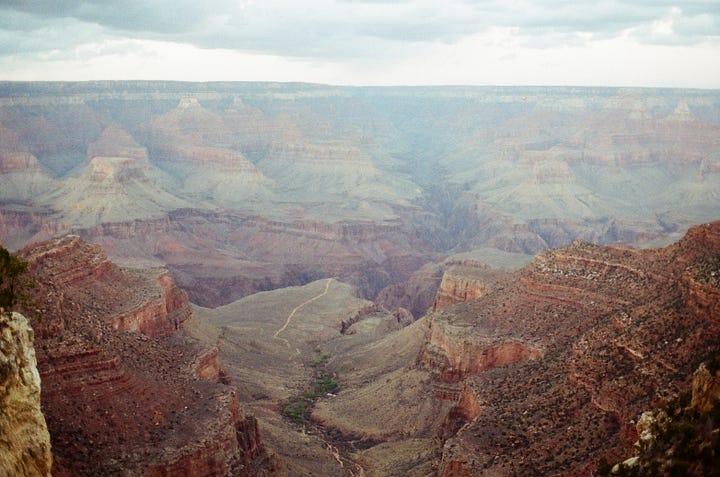
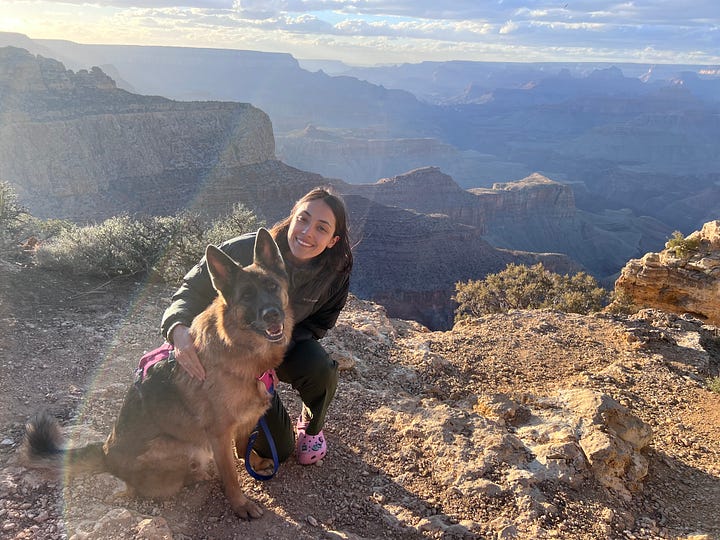
Time: 5 Hours
Notable Stops: Horseshoe Bend, Antelope Canyon, Vermillion Cliffs National Monument, the Navajo Bridge at Marble Canyon
History: The drive from the Grand Canyon to Southwest Utah took us through so many remarkable landscapes with countless opportunities to extend and adjust the route to explore these protected lands. A good chunk of this route also heads through Navajo Nation, which carries it’s own rich history. Beginning to understand the past added a lot more color to our drive, and I’d encourage anyone else on this road trip to spend some time doing the same (a great way to pass the time!)
Despite the previous evenings mild spring weather, we woke to a blanket of snow coating the ground and a flurry of snowflakes dancing in the sky. Not yet ready to say goodbye, we decided to take Violet on her morning walk at the Grand Canyon before another long day on the road.
The drive from Northern Arizona to Southwest Utah was one of the most varied and scenic portions of the entire road trip. Passing through silver-sloped badlands, the colorful stripes of the Painted Desert, almost radioactive-looking green hills, and towering red rocked mesas, every mile brought with it a completely different landscape (and climate!).
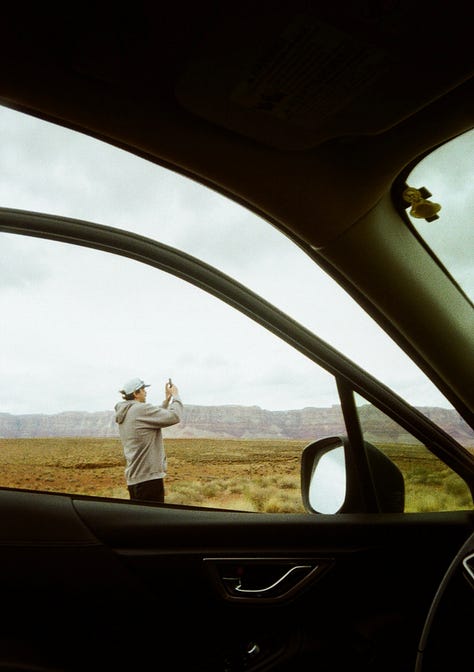
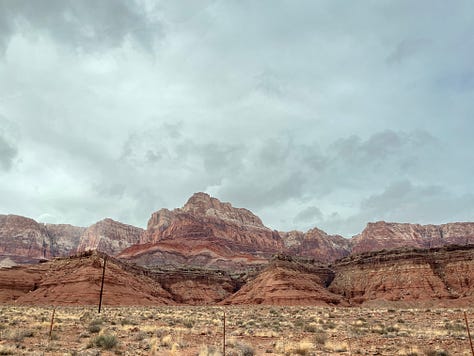
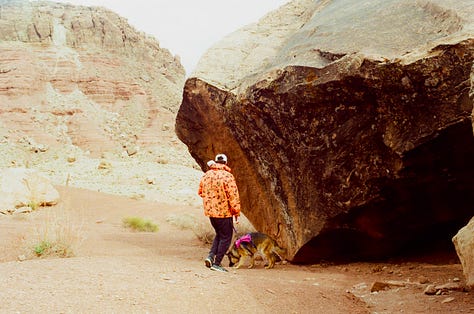
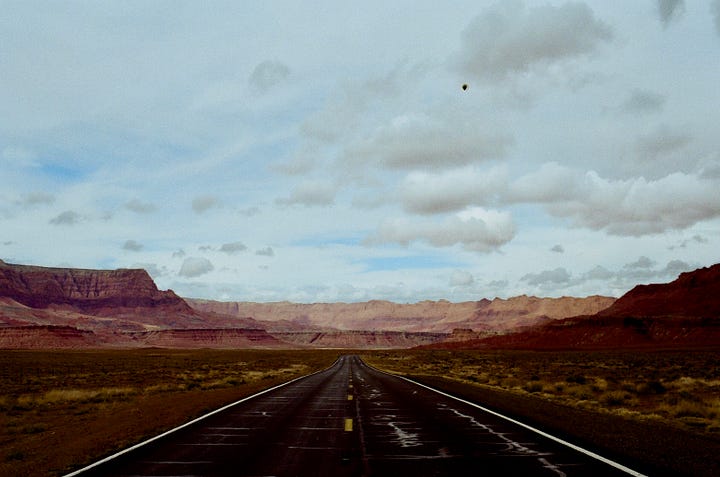
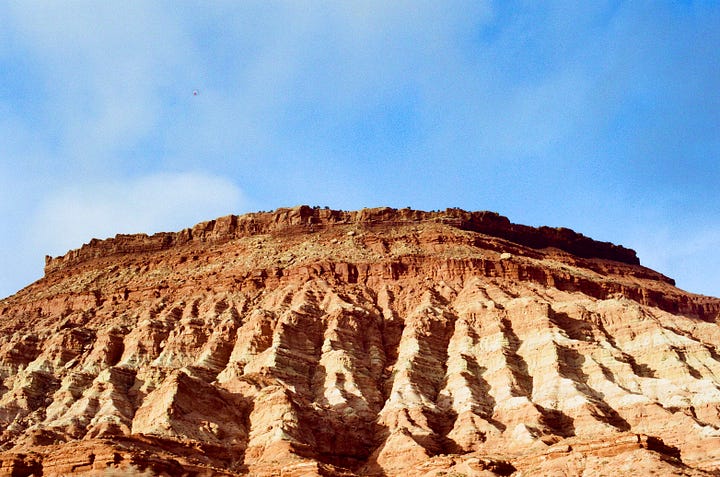
At this point in the trip, we were both a little “over it” and decided not to stop at Antelope Canyon or Horseshoe Bend, however if you are doing this road trip they are both on the route, and would add very little time to stop and visit them both. One thing to note, dogs are not allowed at Antelope Canyon, so if you’re traveling with your furry friend you’ll have to skip this stop.
Where we Stayed: Cedar City, Utah
Distance from the Park: 50 minutes
Hike: Scouts Lookout to Angels Landing (~5 hours, difficult)
What you’ll need: A National Parks Pass or the daily entrance fee of $35, lots of water, and if you’re planning on hiking Angels Landing or The Narrows, your permit & photo ID.
History: Originally frequented by nomadic groups of Native Americans ~7,000 years ago, it wasn’t until AD 1,100 when the Southern Paiute Tribes began establishing longer term settlements in the area. European American settlers and Mormon pioneers arrived in the area in the late 1800s, naming the area Zion - ancient Hebrew for “sanctuary”. The area wasn’t exposed to the general public until 1909 and when surveyors experienced the remarkable landscapes, they urged President Taft to protect it. On July 31, 1909, Taft set aside ~16,000 acres for the Mukuntuweap National Monument (now Zion National Monument), and ten years later, President Roosevelt established a second Zion National Monument, preserving even more of the land. In 1956 the two monuments were combined to establish the National Park we know and love today.
If stepping into Arches National Park felt like touching down on Mars, Zion felt like entering into the set of Jurassic Park. Giant red mounds spotted with green, rose from the ground, towering over the world below. Hiking our way up the strenuous uphill battle of Scouts Lookout, I felt as if I had been transported back in time.
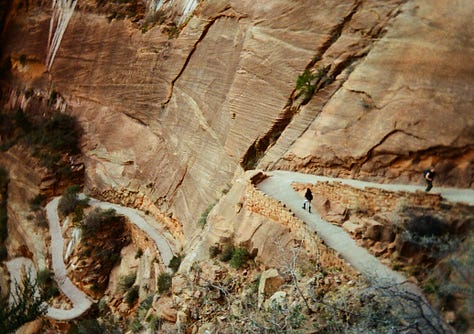
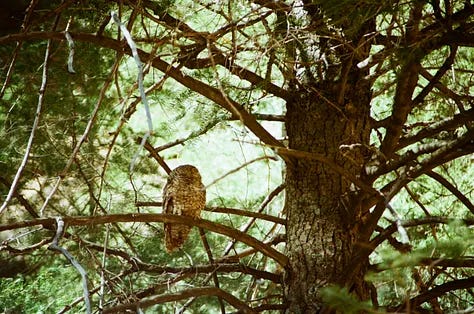
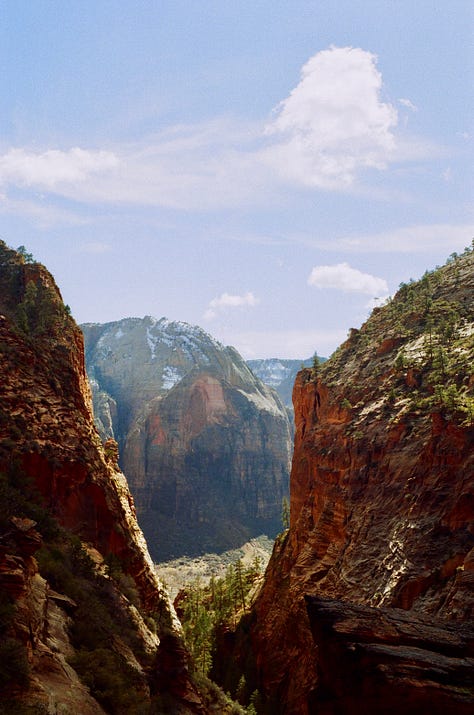

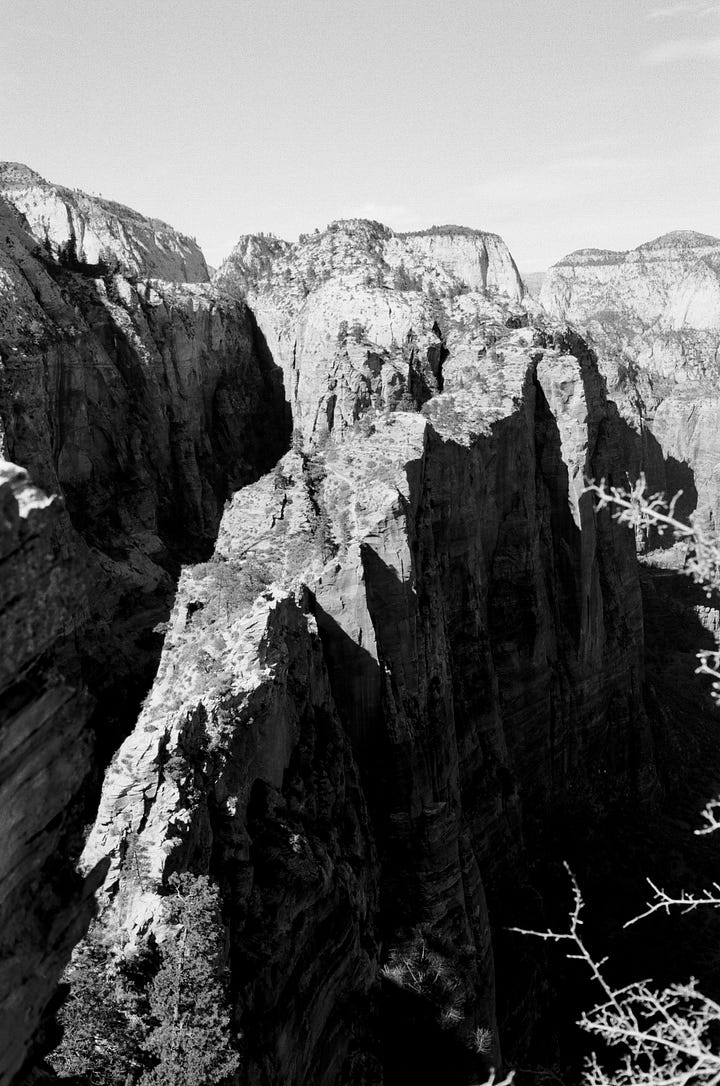
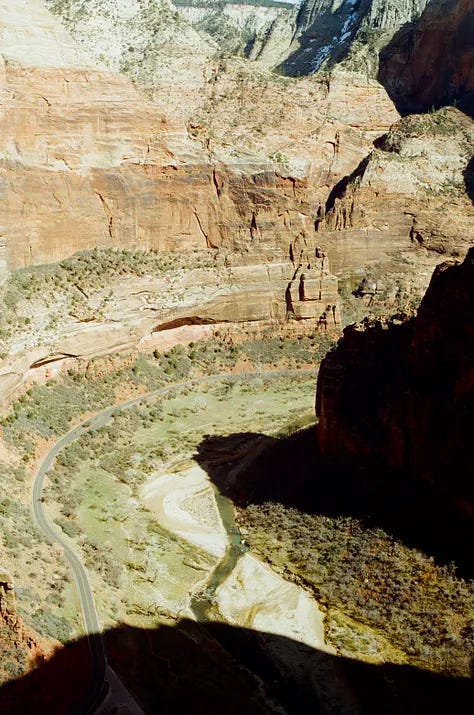
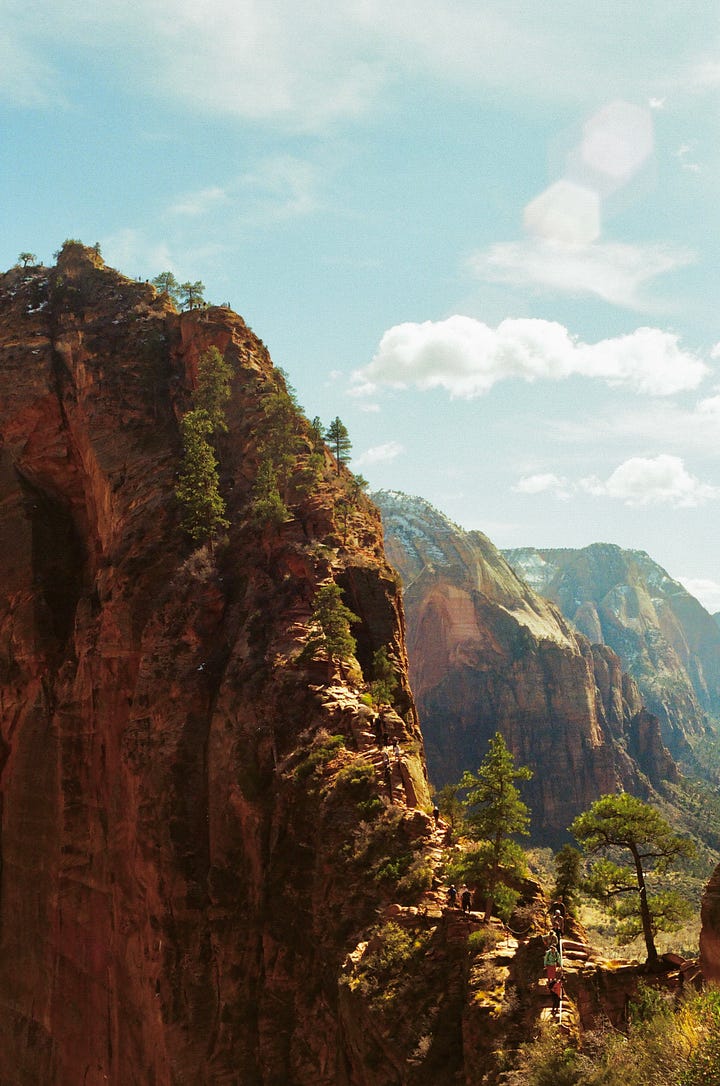
Once we reached the start of the Angels Landing chains portion of the hike, my boyfriend and I split up and made plans to regroup at the Lodge a few hours later. A few things to note about Angels Landing:
The views from the top (and along the way) are absolutely worth the climb. Every time I stopped to let hikers pass or soak in the views, I was awestruck by just how far and high up I had hiked, giving me such a profound gratitude for my body and everything it allows me to do
Arrive early. Despite visiting in the off-season, the chains were incredibly crowded, and I spent a majority of my climb trying to avoid traffic jams and waiting for other hikers to make their way down the mountain. I’ve heard that it get’s even busier in the peak summer season, but is less busy in the morning slots.
It’s not as scary as it looks! Photos make it appear so much more treacherous than it actually is. At no point did I feel unsafe, or feel that it was too strenuous to continue on. Go slow and take a deep breath, you got this!
If your phone dies or you forget to print out the permit, fear not! There are Park Rangers stationed at the start of the chains who can look you up with a photo ID, ensuring that you won’t miss out.
Where we Stayed: Cedar City, Utah
Distance from the Park: 1.5 Hours
Hike: Queens Garden & Navajo Combination (3 Miles, Moderate)
What you’ll need: A National Parks Pass or the daily entrance fee of $35
History: Winters in Bryce Canyon are harsh and unforgiving, making long-term settlement in the area difficult. However, many different cultures have passed through, using the area for hunting, harvesting, and some agriculture. The area’s striking hoodoos, Ponderosa Pine and high elevation meadows create a regal landscape, that when the Union Pacific Railroad made Bryce accessible to modern day travelers, quickly made the canyon a national treasure.
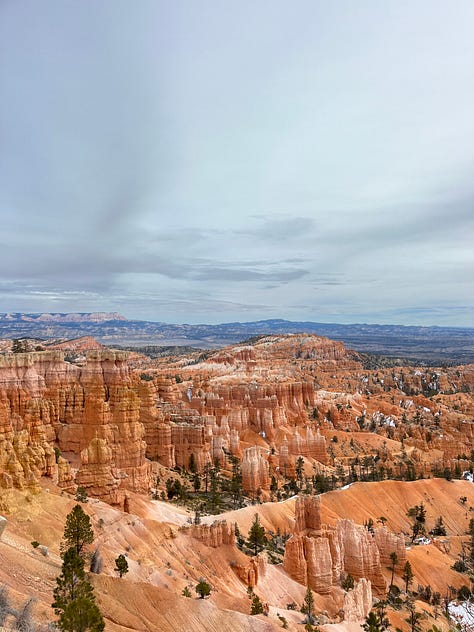
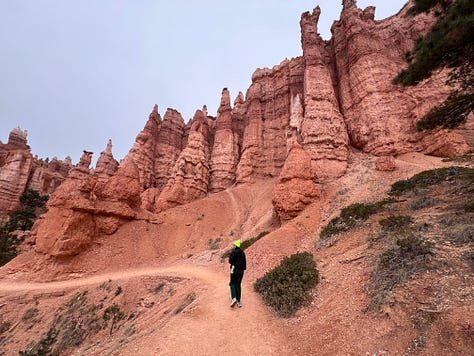

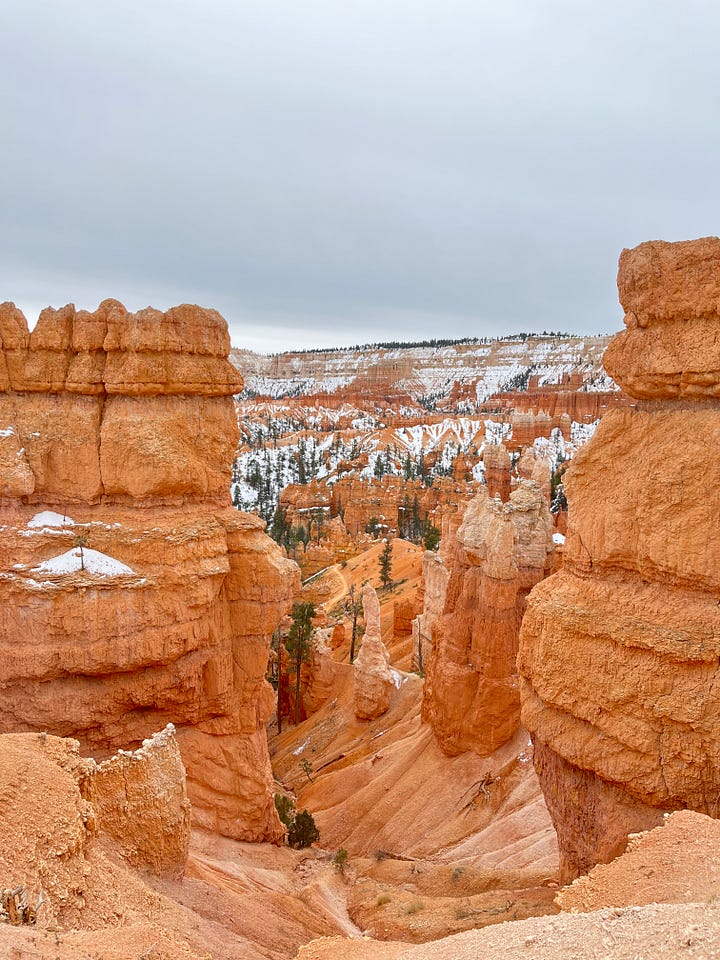
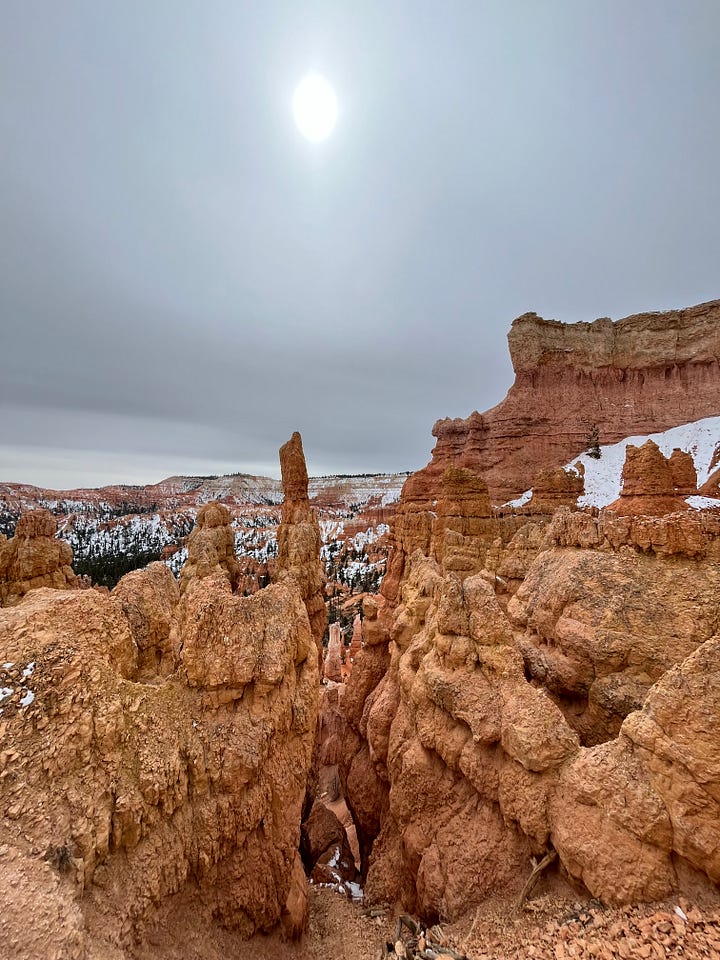
Although the entrance to Bryce Canyon is quiet and unassuming, don’t be fooled. Once you cast your eyes on the vibrant orange spires below, you’ll quickly understand why this park remains an international “must-see”.
The Queens Garden and Navajo Loop are a great way to immerse yourself in the parks’ effortless whimsy. Hiking down the winding path into the canyon with hoodoos towering on all sides and Ponderosa pines sprouting out of the rock at awkward angles, it felt as if I was walking through a giant sandcastle out of a children’s fairytale.
As we made our way to California, we took the long and very rural route to Reno where we stayed a few nights to rest and recover before completing the rest of the journey to northern CA. With Area 51, the Nevada Test Site, Hawthorne Army Depot, so many abandoned mining towns, etc. there was a lot of interesting history to keep us entertained on this leg of the journey.
Depending on how you want to close out your road trip, the 6th day is a great day to head home and rest after a whirlwind journey. Many itineraries start/end out of Salt Lake City or Las Vegas, giving you plenty of flexibility to choose your own adventure home.
I already mentioned this above, but if you’re able, spend more than one night in Moab. My ideal Moab itinerary would be as follows:
Stay 3 nights:
Arrive: Do a dog friendly hike in Moab before checking into your lodging for your first night
First Full Day: Go on a half day of hikes in Arches National Park, before picking up your dog and heading out to Dead Horse State Park for some more hikes/adventures.
Second Day: Wake up early and do one of the many epic hikes through Canyonlands National Park. Then, scoop your pup and check out another dog friendly hike in the evening.
Departure: Wake up early and grab a quick bite before heading out to Monument Valley and the Grand Canyon
Hike below the rim at the Grand Canyon
Because we were traveling with Violet, we didn’t have a chance to hike below the rim of the Grand Canyon during our short visit. That said, if you are traveling without a dog, or are planning to build in more than one night here, I’ve heard that it’s absolutely worth the effort. Bright Angel Trail is one of the most popular hikes, and I’d love to come back and explore a bit more.
Stop in Paige, AZ to visit Horseshoe Bend & Antelope Canyon
Had we not been traveling with a dog/I wasn’t burnt out from so many stops, I would have loved to stop at Horseshoe Bend and Antelope Canyon in Paige, AZ. They both are directly on the route, and would be an easy stop for anyone looking to maximize their Southwest Experience.
It’s worth noting that Violet was recovering from her spinal injury at the time, so taking any sort of dog friendly hikes off the table. If you’re doing a similar road trip I’d recommend starting your Moab adventure with a stop at one of the many Dog Friendly Hikes in the area, and hitting Arches the next morning after checking into an Airbnb so that you can get the full park experience.
To protect the natural ecosystems of these natural wonders, National Parks are not known to be very dog-friendly. That said, leashed dogs are allowed at picnic areas and parking lots (but not inside any buildings!). If you’re planning to bring your pet with you, just be aware that you’ll be limited to the driving route and lookouts (like we were in Arches). Always check the park policies before bringing your furry friend, just to be sure!
If traveling with pets, visit in the winter months. The weather was mild and would have been great for hiking with Violet if she was healthy. However, due to the extreme heat that this area sees in the warmer months, I wouldn’t feel comfortable bringing a pet along.
Travel with a crate & stay at rental properties if you want to experience the National Parks without your pup. Camping would be amazing, but isn’t a realistic option for anyone wanting to hike within the park where your dog can’t come, and while hotels are a convenient option, many do not allow dogs to be left unattended.
Just because you can’t bring your dog with you on any hikes in the parks, there are plenty of dog-friendly hikes in the surrounding areas that let you experience the unique landscape with your furry friend.
Despite record breaking visits in 2024 (over 331 million!), recent cuts to National Parks has left them at risk before the busy summer seasons even begin. Although the 1,000 previously terminated workers have recently been reinstated, it’s so important to continue to show our support for NPS staff and all that they do. Getting outside is already inaccessible for so many, which is why it’s all the more important that we support our public lands and Park Rangers who help ensure that our parks are properly cared for and work to ensure a smooth and safe visitor experience.
How you can help:
Donate to the National Park Foundation or to your favorite Park directly
Get involved with the NPS Volunteers-In-Parks program. With options to volunteer for a day or year-round commitments, there’s an option for everyone.
Contact your local representatives and urge them to prevent any further cuts to park staffing and funding
If you’re new here, welcome! To learn a little more about me and catch up on our journey so far, check out some of the archived posts below 😊
Thanks for reading Sincerely, Soph. If you’d like to follow along on our adventure, please subscribe to support my work. Like what you read? Feel free to share with a friend or tag them in the comments.
Anything you want covered? Questions? Reply to this email or leave a comment to let me know :)
The name comes from the Lakota Tribe who called the place “mako sinca” which directly translates to “bad lands”. While these harsh canyons of loose rock and mud are indeed very difficult to live in, they are other-wordly to look at.
Traditionally Associated Tribes of the Colorado National Monument









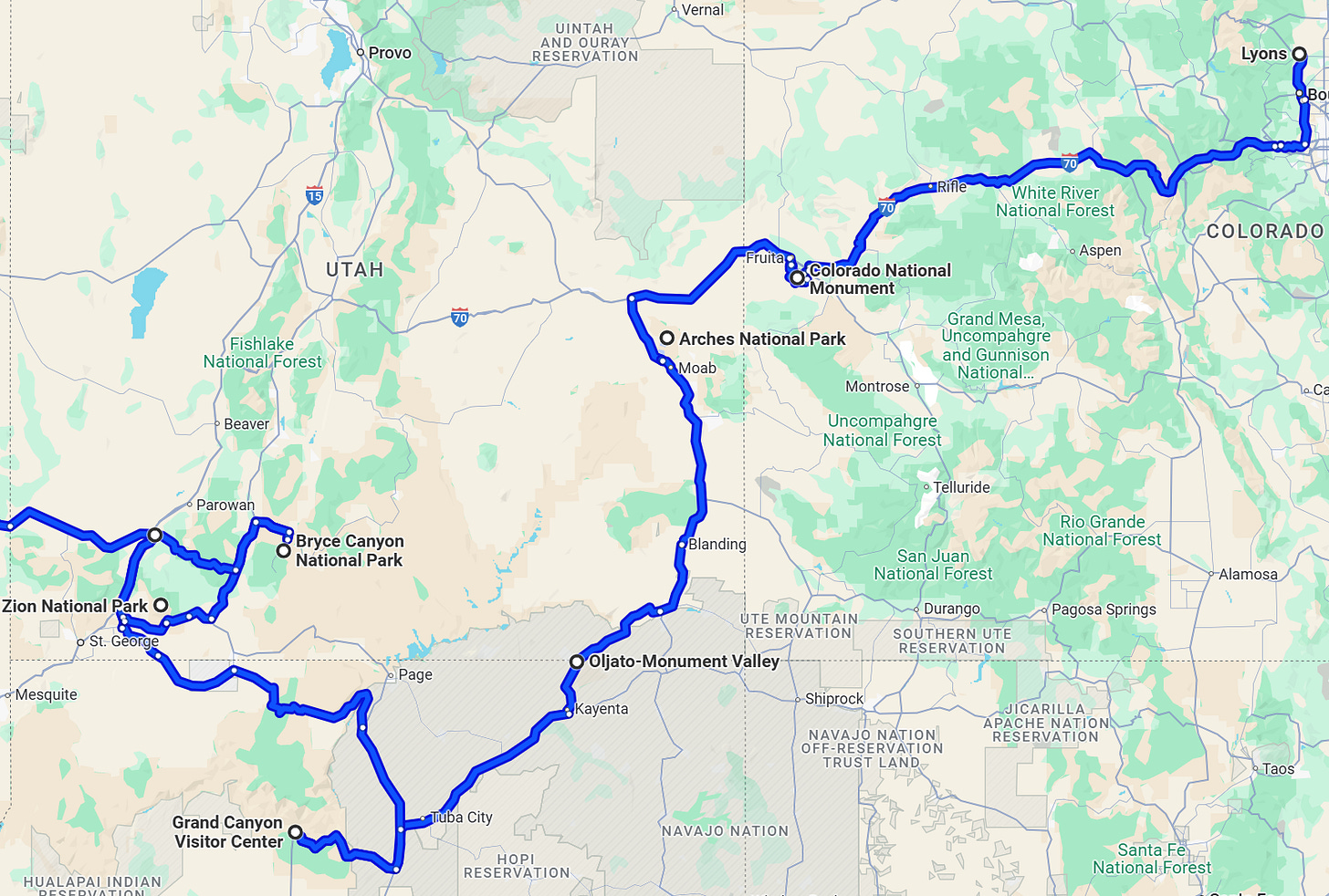

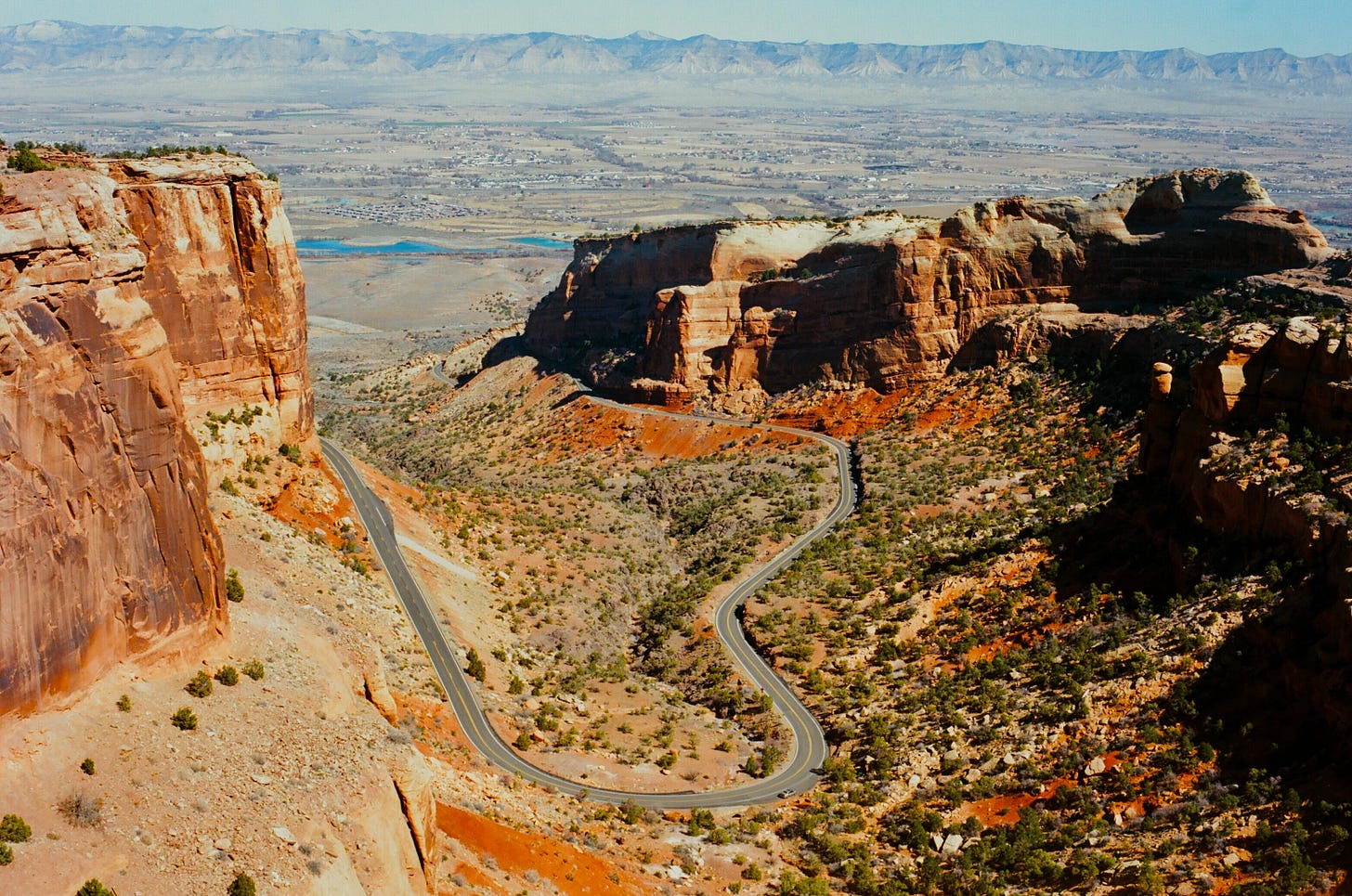

















I love road tripping in this beautiful area!